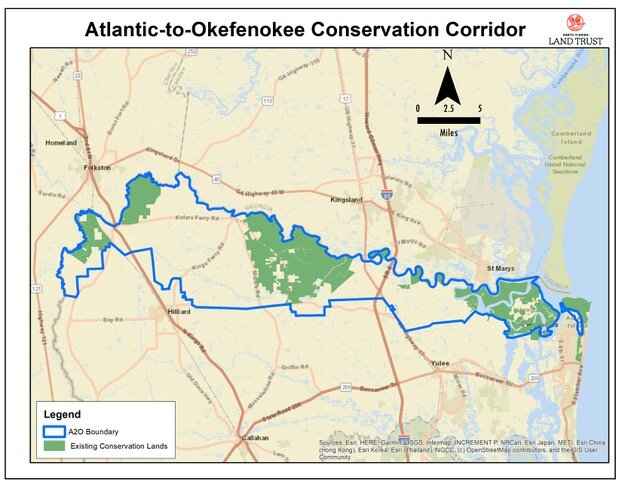Major East-West Corridor Approved for Protection
The Atlantic to Okefenokee Conservation Corridor, more than 55,000 acres of potential conservation land known as the A2O, has been granted a significant approval. The Florida Department of Environmental Protection’s Acquisition and Restoration Council (ARC) has approved the A2O for inclusion on the Florida Forever Priority List. Nassau County and North Florida Land Trust (NFLT), long-time partners in conservation, worked together on the proposal to ARC to consider adding the critical corridor to the priority list.
The A2O stretches from the Atlantic Ocean on the east coast to the Okefenokee National Wildlife Refuge to the west, with 55,864 acres that NFLT and Nassau County hope to preserve. The corridor incorporates the John M. Bethea State Forest, Osceola Wildlife Management Area and the Osceola State Forest complex. The St. Marys River also unifies it at its northern boundary. The river is ecologically, recreationally, and historically significant and a critical habitat for the Atlantic sturgeon, a federally listed endangered species.
“This is a big deal for conservation, and one of the largest expansions of the Florida Forever list that we have seen,” said Allison DeFoor, president and CEO of NFLT.
“This is a huge accomplishment for Nassau County and our residents, who deeply value nature and conservation,” said Brandy Carvalho, Director of Strategic Advancement & Economic Resources for Nassau County.
The A2O completes a 90,000-acre conservation corridor in the southern watershed along 80 miles of the St. Marys River, more than doubling the acres of existing conservation lands near its boundaries. The conservation corridor includes more than 1,200 acres that the state has already identified as necessary additions to Ralph E. Simmons State Forest and Ft. Clinch Preserve State Park.
The A2O includes many extremely important lands for Florida’s ecosystems, including underrepresented natural communities, natural floodplains, priority aquifer recharge lands, fragile coastal resources, and rare species priority areas. Nearly 12,000 acres in the A2O are listed as priorities for Nassau County’s Conservation Land Acquisition and Management program, also known as CLAM. NFLT worked with Nassau County to identify, rank, and assess conservation lands for acquisition and management. Nassau County is the ninth fastest-growing Florida county and faces the threat of development on these ecologically significant lands.
In addition to its environmental significance, the A2O corridor also holds historical importance. The land once served as settlements for Native American nations like the Timucuans, Uchees, and Muskogees, as well as the Gullah Geechee nation. The A2O and St. Marys were important residential, foraging, and fishing areas for the populations, and the northern boundary of the river was part of the St. Marys River Paddling Trail. The A2O also has sites used in the American Revolution, the War of 1812, and the American Civil War.
The next step will be approval by the ARC Board of Trustees before the acquisition of properties or conservation easements within the A2O appears before the governor and cabinet for funding approval, most likely next year.
North Florida Land Trust is a not-for-profit organization dedicated to preserving and enhancing the quality of life by protecting North Florida's irreplaceable natural environment. Founded in 1999, NFLT has preserved tens of thousands of acres of land through the donation or purchase of land as well as conservation easements. NFLT is funded largely by private and corporate contributions and works closely with willing landowners and public agencies at all levels of government, not-for-profit partners, and foundations. For more information, visit nflt.org.






